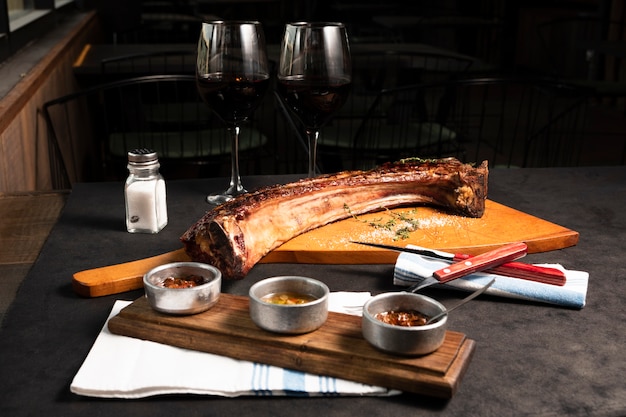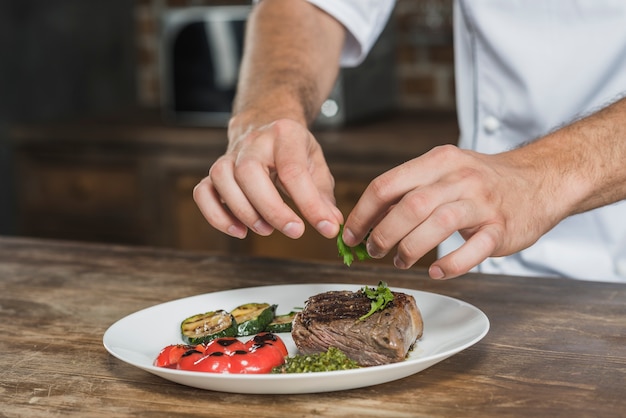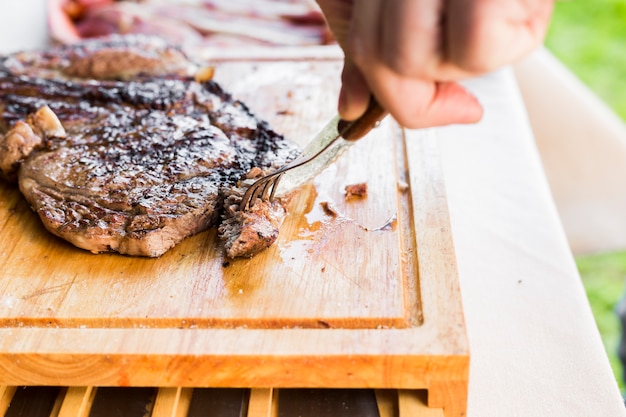(Part 1) Understanding the New York Strip

What is a New York Strip?
First things first, let's get acquainted with our star ingredient. The New York strip, also known as a Kansas City strip, is a cut of beef from the short loin, which is a particularly tender and flavourful section. This cut is known for its rich, beefy flavour and delicate marbling, making it a true favourite among steak enthusiasts. You can tell a New York strip by its rectangular shape, with a nice, thick layer of fat along one edge – that's what gives it that gorgeous marbling and juicy flavour. Now, I'm a big believer in good quality meat, and I always recommend looking for a USDA Prime or Choice grade for the best results. Trust me, the difference in flavour and tenderness is truly noticeable.
choosing the right steak
Now, let's talk about picking the perfect steak. You want a steak that's about 1-inch thick, because that's ideal for achieving a nice sear on the outside while keeping the inside juicy and tender. If you find yourself with a thinner steak, don't worry, it can still turn out delicious, but you'll need to adjust your cooking time to prevent overcooking. You'll also want to look for a steak with even marbling, which means the fat is distributed evenly throughout the muscle. This ensures consistent flavour and tenderness throughout the steak. Don't be afraid to ask your butcher for advice; they're usually happy to help you choose the perfect steak for your needs. You can even ask them to dry-age it for you, which adds depth and complexity to the flavour. Dry-aged beef is a real treat for the discerning palate. The aging process concentrates the flavour and creates a more tender texture.
The Importance of Temperature
One of the biggest secrets to a great steak is temperature. You see, the temperature of your steak is going to determine how long it needs to cook to reach your desired level of doneness. It's all about finding that sweet spot where the exterior is beautifully seared and the interior is cooked to your preference. Now, I've always been a fan of a medium-rare steak, but hey, everyone has their preference. Some people prefer a well-done steak, while others enjoy the juicy tenderness of a rare steak. The important thing is to cook the steak to your liking. Just make sure you're using a meat thermometer to check the internal temperature for the most accurate results. Trust me, a meat thermometer is your best friend in the kitchen when it comes to cooking steak perfectly.
(Part 2) Preparing Your Steak

Getting Ready
Before you start cooking, there are a few things you'll need to do to prep your steak. First, remove it from the fridge and let it come to room temperature for about 30 minutes. This will ensure that the steak cooks more evenly. Imagine the steak as a delicate ballet dancer, warming up before taking the stage. By bringing it to room temperature, you're helping it achieve a more even and consistent cook. Then, pat it dry with paper towels, which will help the steak sear beautifully. A dry surface creates a beautiful crust that locks in the juices and enhances the flavour.
Seasoning
Now, this is where things get really fun! You can season your steak with whatever you like, but I usually keep it simple. Salt and freshly ground black pepper are all you really need to bring out the natural flavour of the steak. The beauty of a New York strip is its inherent flavour, so let those natural notes shine through. However, if you're feeling fancy, you can add some garlic powder, onion powder, or even a sprinkle of paprika. Just remember, less is more when it comes to seasoning. You want to enhance the flavour, not overpower it.
A Touch of Herbs
For a more sophisticated flavour profile, consider adding fresh herbs to your seasoning mix. A sprinkle of thyme, rosemary, or oregano can really elevate the flavour of your steak. I like to use a combination of herbs, but feel free to experiment and find your favourite blend.
(Part 3) Cooking Methods

Grilling: A Classic Approach
Okay, we're getting down to business. Let's start with grilling, the classic way to cook a New York strip. Preheat your grill to medium-high heat. Now, before you place your steak on the grill, brush the grill grates with a little oil to prevent sticking. This is a crucial step, because a clean grill prevents the steak from sticking and helps create those beautiful grill marks. Once the grill is good and hot, place your steak on it and cook for 2-3 minutes per side for a medium-rare steak. Now, here's a little trick I learned from my dad: use tongs to flip the steak, not a fork, because piercing the steak can release valuable juices. The goal is to lock in the flavour and moisture, creating a tender and juicy steak. Keep cooking the steak until it reaches your desired internal temperature. The sear marks will be a beautiful indicator of a perfectly cooked steak.
Pan-Frying: An Indoor Delight
Now, if you don't have a grill, don't worry, pan-frying is another great option. Heat a heavy-bottomed skillet over medium-high heat. A heavy skillet helps distribute heat evenly, ensuring a consistent cook. Add a tablespoon of oil, then let it get nice and hot. The oil should shimmer slightly, indicating it's ready for the steak. Place the steak in the skillet and cook for 2-3 minutes per side, or until it develops a beautiful crust. Now, here's the fun part: add some butter, herbs, and garlic to the pan and baste the steak with the mixture for that extra flavour boost. The butter will melt and infuse the steak with incredible flavour. Keep cooking the steak until it reaches your desired internal temperature. The result is a steak that's crispy on the outside and juicy on the inside, with a delicious aroma that fills the kitchen.
Oven Baking: A Simple and Efficient Method
Okay, let's talk about oven baking. You can achieve that classic steakhouse look and flavour by baking your strip steak in the oven. Preheat your oven to 400°F (200°C). Season your steak, then place it on a baking sheet. Bake for 10-12 minutes for a medium-rare steak, flipping halfway through. This method is great for those who prefer a more hands-off approach. The oven does most of the work, allowing you to focus on other aspects of your meal. Now, this is a great option if you want to cook multiple steaks at once, which is perfect for a family dinner or a gathering with friends. Everyone can enjoy a perfectly cooked steak without the hassle of juggling multiple pans on the stovetop.
(Part 4) Cooking Times and Temperatures
steak doneness chart: Your Guide to Perfection
Now, let's get into the nitty-gritty details about cooking times and temperatures. I've always been a fan of using a meat thermometer, because it's the most accurate way to ensure your steak is cooked to perfection. Don't leave your steak's fate to chance! A meat thermometer takes the guesswork out of cooking and ensures you get the perfect level of doneness every time. But don't worry, I've got a handy-dandy chart for you that summarizes the ideal cooking times and internal temperatures for different levels of doneness.
| Doneness | Internal Temperature (°F) | Internal Temperature (°C) | Cooking Time (per side) |
|---|---|---|---|
| Rare | 125-130 | 52-54 | 2-3 minutes |
| Medium-Rare | 130-135 | 54-57 | 3-4 minutes |
| Medium | 140-145 | 60-63 | 4-5 minutes |
| Medium-Well | 150-155 | 65-68 | 5-6 minutes |
| Well-Done | 160 | 71 | 6-7 minutes |
Remember, these are just guidelines. The actual cooking time may vary depending on the thickness of your steak and the heat of your grill or pan. It's always best to use a meat thermometer to ensure your steak is cooked to your liking.
(Part 5) Resting Your Steak: A Crucial Step
Let it Rest!
Okay, you've cooked your steak to perfection, now it's time for a little patience. Let your steak rest for 5-10 minutes before slicing and serving. This allows the juices to redistribute throughout the steak, resulting in a more tender and juicy bite. Think of it as a moment of relaxation for your steak after its culinary journey. This step is often overlooked, but it truly makes a difference in the final outcome. The juices will reabsorb into the steak, ensuring a moist and flavorful experience.
(Part 6) Serving Your Steak: A Culinary Showcase
Dress it Up
Now, it's time to make your steak the star of the show. There are endless possibilities when it comes to serving a New York strip, but I like to keep things simple and let the flavour of the steak shine. The key is to create a balance of flavours and textures that complement the steak without overpowering it.
Sides: Complementary Flavors
When it comes to sides, I love to pair my steak with classic favourites like mashed potatoes, asparagus, or a simple green salad. These sides provide a delightful contrast in texture and flavour, creating a harmonious culinary experience. But really, the possibilities are endless! You can get creative with your sides and choose options that align with your personal preferences.
Sauces: A Touch of Luxury
A simple sauce can elevate your steak to new heights. Try a classic Béarnaise sauce, a tangy chimichurri sauce, or a rich red wine reduction. The sauce should complement the flavour of the steak without overwhelming it.
(Part 7) Tips and Tricks: Mastering the Art of Steak Cooking
Tips for Success: Ensuring a Perfect Steak
Here are a few extra tips and tricks I've picked up over the years that will help you cook a perfect steak every time.
- Use a meat thermometer! This is the best way to ensure your steak is cooked to your liking.
- Don't overcook your steak! Overcooked steak can be dry and tough. Remember, a little pink is a sign of a juicy and flavorful steak.
- Rest your steak before slicing! This will help the juices distribute evenly.
- Experiment with different seasonings! There's no right or wrong answer here, so find what you enjoy. Let your creativity shine through!
- Use high-quality meat. As they say, you get what you pay for. A good cut of meat will make a world of difference in the final result.
(Part 8) FAQs: Addressing Your Steak-Related Questions
Q: What is the best way to cook a New York strip steak?
A: Honestly, there is no one "best" way to cook a New York strip steak. The best method depends on your personal preference and what equipment you have available. Grilling, pan-frying, and oven baking are all great options, each with its own unique benefits.
Q: How long should I cook a New York strip steak for a medium-rare?
A: You should cook a New York strip steak for about 3-4 minutes per side for a medium-rare. However, it's always best to use a meat thermometer to ensure it's cooked to your liking.
Q: What should I serve with a New York strip steak?
A: A New York strip steak pairs well with classic sides like mashed potatoes, asparagus, or a simple green salad. But feel free to get creative and experiment with different options.
Q: How can I tell if my steak is done?
A: The best way to tell if your steak is done is to use a meat thermometer. You can also use the "finger test", but it's not as accurate as a thermometer. To use the finger test, press on the steak to see how firm it is. A rare steak will be soft and springy, a medium-rare steak will be firmer, and a well-done steak will be very firm.
Q: What happens if I overcook my steak?
A: If you overcook your steak, it will become dry and tough. The best way to avoid overcooking is to use a meat thermometer and check the internal temperature frequently.
Alright, there you have it! I hope this ultimate guide has helped you gain some confidence in your steak-cooking skills. Remember, practice makes perfect, and don't be afraid to experiment with different techniques and seasonings to find what you enjoy the most. So, grab your favourite cut of New York strip steak, gather your ingredients, and get ready to create a culinary masterpiece! Happy cooking!
Everyone is watching

How to Cook Frozen Lobster Tails Perfectly: A Step-by-Step Guide
RecipesLobster. Just the word conjures up images of lavish meals, special occasions, and a taste of luxury. But let's...

Pigs in a Blanket Cooking Time: How Long to Bake for Perfect Results
RecipesAh, pigs in a blanket. Just the name conjures up images of those delightful little parcels of crispy pastry en...

Pork Fillet Cooking Time: How Long to Cook It Perfectly
RecipesPork fillet, or tenderloin as it's sometimes called, is a real favourite in our house. It's so versatile, and...

The Ultimate Guide to Tender, Juicy Pulled Pork
RecipesRight, let's talk pulled pork. It's one of those dishes that just screams "comfort food," doesn't it? I mean...

The Ultimate Guide to Cooking Sweet Potatoes: From Roasting to Mashing
RecipesSweet potatoes. Just the name conjures up images of warm, comforting dishes, bursts of vibrant color, and a to...
